
September 24, 2014, by Hannah Curnock
A Bird’s eye view: climbing the University of Nottingham Trent Building Clock Tower
This week’s blog comes to you from Gaby Neher, Assistant Professor of Art History here at The University of Nottingham. Gaby originally posted this on her blog, but we thought it was such an interesting perspective of The University that we’d re-post it. So here it is:
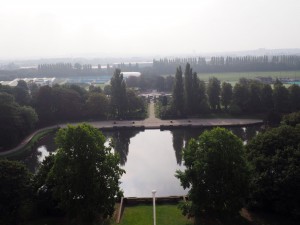
View over Highfields Park
It is possible to become used to beautiful surroundings, so occasionally, I try and make sure that I take a step back from my work, leave my desk at lunchtime and walk around the stunning grounds of University of Nottingham’s University Park. Apart from getting some fresh air, such a walk is a great way of reminding myself that the University is a purpose-built, carefully constructed and planned space where a core of 1920’s buildings has been – and continues to be- extended. I am also in the process of overhauling and re-launching one of my Department’s most cherished modules, a core element of study in second year that combines a site visit abroad (Paris in 2014, Berlin in 2015) with the development of an extended independent research project. For the new version of this module I am going to be working with the students for a whole semester on exploring key civic sites in Nottingham, and several sessions will focus on the development and architecture of both University park, with its iconic 1920s buildings, and the much more modern Jubilee Park, developed on the site of the old Raleigh Factory.
It’s a module about looking and studying art and buildings first hand and in situ, because – and yes, this sounds obvious- building takes a lot of planning, time, money and space, and buildings often interact in very interesting ways with their surroundings. In fact, buildings both signify and become signifieds of their environment, and often the most successful spaces are ones where as a user of this space, you don’t notice the way in which your actions and behaviour are influenced by the arrangement and organisation of the space. In other words, it is always well worth understanding your surroundings and what better way to start than by climbing to the highest point you can find, and have a look? I hasten to add that any such climbing should be undertaken safely, of course and in the case of climbing where I went, on top of the University of Nottingham’s major landmark, the clock tower of the Trent Building, this required some special pleading and permission to do so in the company of one of the University’s members of the Estates Department! So, don’t try and do this yourself…. One of the reasons for visiting the space was to establish whether it might be possible to access the space with a group of students and the answer is a clear no. I was allowed though to take photographs of this visit (the full set is here, on Flickr), and had plenty of time to have a look around at the extraordinarily beautiful surroundings of the campus.
So, what can you see from above? First of all, you can see just how carefully the environment of University Park has been composed. There is very little that is entirely natural about the landscape of University Park and adjacent Highfields Park- it’s environment has been maximised, shaped and sculpted in the best tradition of Capability Brown to create a series of distinctive views and vistas. The original parts of campus create a green oasis, a ‘lung’ within the urban context of Nottingham where fresh, clean air allows art and culture and education to flourish-its about the health of body and mind, and architecturally this is expressed in the wonderful sweep of The Trent and Portland buildings that continues to envelop the original Lakeside buildings, both the Boating House and Lake and the Lido that stood at the site now occupied by the Djanogly Gallery and Recital Hall complex, and partially under the new tram line. Buildings, road and trees sweep around these buildings, with a circle completed by the (artificial) lake. Bear in mind though that completing this circle took quite some time, because while the Trent Building dates to 1927, the Boating House wasn’t added until 1952 and the Portland Building only opened in 1956. The University of Nottingham’s Mansucripts and Special Collections (on King’s Meadows Campus) have made Historic Collections available online, including one database that contains over 300 photos of the University. A careful look through this treasure trove shows quite clearly how the landscape and environment of the University has changed and developed, with some of the most dramatic changes dating to the last decade.
The overriding principle of the design, of creating a centre with surrounding branches, like a hub-and-spoke motif that underpins the architecture of the university is actually visible at the very heart of the space, the inner courtyard of the Trent Building and reinforces this sense of an integrated vision of civic and educational excellence, and certainly the bones of this plan are still viusible from above, on climbing the Tower.
View from the Balcony into the Trent Courtyard
But before I turn to the Tower itself, the views from above frame an unexpected building, affording it a visual prominence from above that is not matched by any other building. Can you guess?
It’s Florence Boot Hall, at the end of the West Drive, opened in 1928. Florence Boot Hall is the oldest Hall of Residence on University Campus, and was originally an all-female hall- so, from 1928, the University of Nottingham had a dedicated residence for female students, donated by Lady Florence Boot (1863-1952), the wife of Sir Jesse Boot, 1st Baron Trent (1850-1931) whose benefactions made the construction of the Trent Building (see what happened here?) possible in the first place. Jesse Boot’s philanthropic role is arguably much better understood than that of his wife Florence, but the foundation of a Hall of Residence for female students is a pretty amazing legacy to be remembered by, and as I suggested above, Florence’s Hall is afforded a very high visual status indeed in the original plans for campus, through its close visual proximity to the Westr Drive and the way in which the landscaping frames the hall, simultaneously shielding it from external view from beyond campus and visually emphasising its significance for the University. Both of the Boots, of course, both Florence and Jesse, devoted significant funds to sponsoring education and sport (educating body and mind) , and not just in Nottingham but also on Jersey. Lady Boot was originally from St. Helier, and the couple retired to Jersey in 1928 when Sir Jesse’s arthritis worsened. He died on Jersey in 1931 and was buried in the parish church of St. Brelade, with Lady Florence commissioning the extraordinary St. Matthew’s church at Millbrook, St. Lawrence, with its Rene Lalique altarpiece…
Abandoned mount for a telescope on the roof of the Trent Building
Climbing towers and seeking vantage points does certainly allow for reflection on patterns of things seen from above, but the ascent itself is also always well worth taking time over. And again, the Trent Building Clock Tower did not disappoint. It is clear that the Tower was constructed with ease of access in mind, mainly for two reasons, I suspect. One would be to permit use of the magnificent roof of the Trent Building, for example for star gazing (as borne out by the abandoned mount for a telescope still there) and then of course for reasons of maintenance. There are old telecommunications boards, an air raid siren and the wonderful mechansims for the clock and bells of the tower, and that sort of clobber takes up a lot of space. So, the inside of the tower is predominantly a functional space and yet there are passages and sections of quite startling beauty. At one point, the narrow, steep and rather utilitarian wooden steps give way to a truly magnificent staircase with rather splendid ironwork railings. The ascent is slow, but skillfully constructed, because there are plenty of views that reward the intrepid visitor (or maybe more routinely, the electrician doing maintenance work!) for their efforts, with the views on the balcony level just below the clock face the most spectacular of them all. It did feel very special indeed to be standing on those balconies looking out at the grounds of the University below, and with views stretching for miles towards the Vale of Belvoir and across the Trent valley.So, always look up, climb on things and look down. There is nothing like a bird’s eye view to make sense of your surroundings. Buildings and spaces create an environment for social engineering, and in the case of Nottingham University, it speaks of a vision, it speaks of an ideal of education of body and mind. A beautiful context allows the peace and space to think. Which is a very nice thought indeed.
Winding staircase, Trent Building
Clock mechanism in the Trent Building
Behind and underneath the Trent Building Clock face
View across the roof of the Trent Building
All photo credits: Gabriele Neher, University of Nottingham

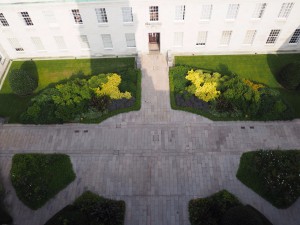
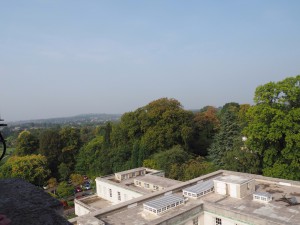
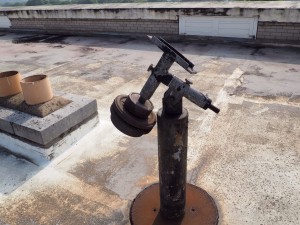
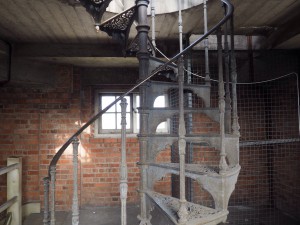
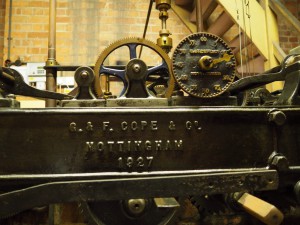
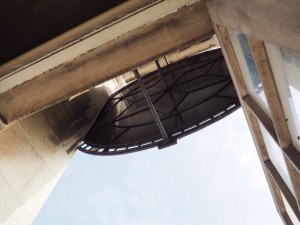
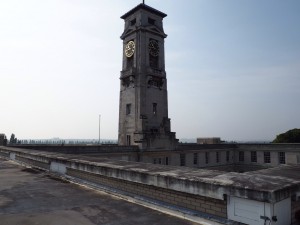
I found this very interesting, apart from one very sad-looking picture captioned “Abandoned mount for a telescope on the roof of the Trent Building”. In the late 1970s when I was first a student at Nottingham, there was a thriving AstroSoc which used to carry out regular observations using the telescope on top of Trent Building. In the late 1980s while undertaking a part time M.Sc. back at Nottingham along with another alumnus, we started reminiscing and wondered whether the telescope was still there. AstroSoc was by this stage defunct, but with the permission of the Students’ Union, one evening we went along to the security office in Trent Building and were given the keys to the roof and the shack where the telescope was housed. The telescope itself was a magnificent piece of Victorian engineering in brass, the largest telescope I had used at that time, and I still remember the stunning view of the full Moon through it, with well-defined jagged peaks visible all over the Moon’s surface. I often wondered whether the telescope was still there; sadly this blog appears to show that it has been removed. Can anyone shed any light on what might have happened to the antique telescope after it was taken away?
Hi Mark, I’ve spoken to a few colleagues about your query and will send you an update in a short while re the telescope.
Hi! Gaby is actually one of my professors right now and I was researching the latin inscription on the tower just for curiosity, but are students allowed to climb the clock tower and go to the roof? Just…to be able to look around? I’m an American exchange student and I assume the answer is, “No,” but I would love to be able to climb the winding stairs and take photographs and maybe even sketch the view in my moleskine.